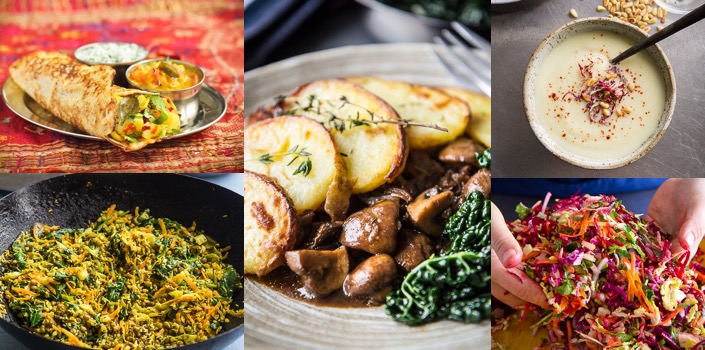Bridge the 'Hungry Gap' with these 5 delicious recipes

The 'hungry gap' is named after the break between the end of the winter vegetables and the first of the first spring produce. This gap starts in March and is surprisingly long as, as homegrown spring veg are generally not ready to pick until May and June. Historically, the early spring months did not bring an overflowing bounty of fresh vegetables with might imagine, but rather a continuation of winter crops and foraged weeds. There is even a variety of kale called ‘hungry gap kale’ which was introduced during the war as a late winter variety.
The choice may be limited, but vegetables such as cabbages and Jerusalem artichokes are very versatile. I like to get creative and spice them up with some of my favourite store cupboard spices, including mustard seeds, curry leaves and Aleppo pepper. This is also a great time of year to make use of pulses, lentils and nuts to add texture, substance, and protein to your cooking.
To help inspire you during this challenging time of year, here are our five top ingredients for bridging the hungry gap, plus recipes to go along with them:
Cabbage
Cabbages grow 52 weeks of the year in Britain and I feel sometimes get forgotten in the popularity of kale which are all part of the Brassica family.
At this time of year either choose the solid heavy cabbages or spring greens, which are picked before they heart up. To prep a large cabbage take the outer leaves off and cut the cabbage into quarters and then remove the hard central core which is lovely to eat raw! Finely slice the cabbage and sauté or add to a coleslaw.
Try cabbage in this zesty recipe for Winter Coleslaw with Barberries:
Jerusalem Artichokes
Jerusalem artichokes have a delicious nutty flavour and make a lovely creamy white soup. They're also excellent roasted or cooked in a pan with onion, garlic and tomato. This vegetable does have a reputation for causing wind, however, and this is because they contain inulin, a sugar that when digested by the bacteria in the gut produces a lot of gas, but some people are affected more than others. I find that par-boiling them first and then discarding the water gets rid of the inulin, but other people say that eating them raw or adding a bay leaf to the cooking water also helps reduce the effects.
Try Jerusalem Artichokes in our recipe for Jerusalem Artichoke Soup:
Seitan
Seitan is flavoured wheat gluten, the protein portion of wheat that gives bread dough its elastic quality. It has been used as a meat substitute for centuries in China and Japan, where vegetarian Buddhist monks developed it. Seitan adds texture and protein. Seitan is vegan and very high in protein. The best tastiest seitan is a brand called' Yakso' and comes in a jar, marinated in flavoured tamari. It's only available in wholefood shops.
Seitan was a popular wholefood addition in the 80s, but has lost popularity as its diametrically opposite to the trend in Gluten free foods as it is pure gluten (and thus not suitable for anyone with a gluten intolerance). It is coming back into fashion and we are running course at Demuths cookery school on how to make your own seitan.
Try seitan in this undeniably comforting Mushroom and Seitan Stew with Crispy Potatoes:
Store Cupboard Spices
Curry leaves are one of my favourite additions to curries and they add a distinctly authentic taste. It’s best to buy fresh curry leaves, as dried loose their flavour. You can buy fresh from Indian supermarkets, a bunch is very cheap and they freeze well, just make sure you wrap them carefully, otherwise everything in your freezer will soon smell like curry leaves. Wash them well before cooking and don’t eat them raw – rather like bay leaves they give flavour to a dish and are then removed and discarded.
Mustard seeds are the hot and bitter brown seeds of the annual mustard plant which is part of the Brassica family. Make sure you buy the small brown mustard seeds, the larger black mustard seeds are for pickling. In Indian cooking they are used whole and fried in oil until they pop and release their hot mustardy flavour. Whole mustard seeds are brown on the outside and yellow inside, so when ground they turn yellow!
Put your Indian spices to use with our recipe for Indian Dosas with Sukha Aloo:
Mung beans
I’m a great fan of the dried small green mung beans, they cook quickly and don’t need soaking beforehand, they keep their shape and colour and make a stir fry into a far more substantial dish. Pulses – which include beans, peas and lentils – are a nutritious addition to a vegan diet and when combined with grains provide a complete protein.
Try mung beans in this exotic Keralan Mung Bean Thoran (which also includes cabbage, our other hungry gap favourite!):
Delicious food photography by Rob Wicks of Eat Pictures.
Find us on Facebook, Twitter, Pinterest and Instagram where we are chatting about all things foodie and, if you like this post, please share it!
To keep up to date with events and goings on at the cookery school sign up for our newsletter.








